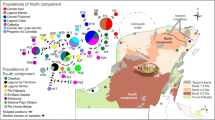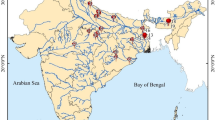Abstract
The genetic diversity and population genetic structures of Drupella cornus populations from six localities in the northern Gulf of Eilat (GOE) and five localities in Tanzania (269 individuals) were investigated using mitochondrial cytochrome c oxidase subunit I (COI) gene sequences. Overall, 107 haplotypes, 47 in GOE and 61 in Tanzania, revealed similar haplotype diversity for the D. cornus populations within each location (0.9 ± 0.00025 and 0.903 ± 0.00078 respectively), with only a single haplotype shared between the two regions. Network analysis for the 107 COI haplotypes displayed two major clades separated by nine mutations, and Bayesian analyses of population structures revealed two clusters highly correlated with the collecting region. Analysis of molecular variance showed that 73% of the molecular variance for all Drupella populations is based on differences among regions. Within regions, most of the molecular variance is based on within population differences, north vs south in Tanzania (89%) and Israel vs Jordan in GOE (98%). Fu’s Fs and Tajima’s D values for all populations were negative, suggesting that the Drupella populations in both regions underwent population expansion or purifying selection. Based on the differences in genetic structuring within populations, the study strongly recommends application of conservation approaches that suit the description of the population in each region.




Similar content being viewed by others
References
Al-Horani FA, Hamdi M, Al-Rousan SA (2011) Prey selection and feeding rates of Drupella cornus (Gastropoda: Muricidae) on corals from the Jordanian coast of the Gulf of Aqaba Red Sea. Jordan J Biol Sci 4:191–198
Antonius A, Riegl B (1997) A possible link between coral diseases and a corallivorous snail (Drupella cornus) outbreak in the Red Sea. Atoll Res Bull 447:1–9
Antonius A, Riegl B (1998) Coral diseases and Drupella cornus invasion in the Red Sea. Coral Reefs 17:48
Armstrong S (2009) The status of the coral predator Drupella cornus at Ningaloo Marine Park. Information Sheet 11/2009 Science Division DEC, 102 pp
Ayre DJ, Dufty S (1994) Evidence for restricted gene flow in the viviparous coral Seriatopora hystrix on Australia’s Great Barrier Reef. Evolution 48:1183–1201
Ayre DJ, Hughes TP (2000) Genotypic diversity and gene flow in brooding and spawning corals along the Great Barrier Reef, Australia. Evolution 54:1590–1605
Ayre D, Hughes T (2007) Genotypic diversity and gene flow in brooding and spawning corals along the Great Barrier Reef, Australia. Evolution 54:1690–1605
Ayre DJ, Miller KJ (2004) Where do clonal coral larvae go? Adult genotypic diversity conflicts with reproductive effort in the brooding coral Pocillopora damicornis. Mar Ecol Prog Ser 277:95–105
Ayre DJ, Hughes TP, Standishi R (1997) Genetic differentiation reproductive mode and gene flow in the brooding coral Pocillopora damicornis along the Great Barrier Reef, Australia. Mar Ecol Prog Ser 159:175–187
Barco A, Claremont M, Reid DG, Houart R, Bouchet P, Williams ST, Cruaud C, Couloux A, Oliverio M (2010) A molecular phylogenetic framework for the Muricidae a diverse family of carnivorous gastropods. Mol Phylogenet Evol 56:1025–1039
Boucher LM (1986) Coral predation by muricid gastropods of the genus DrupeUa at Enewetak, Marshal Islands. Bull Mar Sci 38:9–11
Bryden HL, Beal LM, Duncan LM (2003) Structure and transport of the Agulhas current and its temporal variability. J Oceanogr 61:479–492
Carpenter KE, Barber PH, Crandall ED, Ablan-Lagman CA, Ambariyanto-Mahardika GA (2011) Comparative phylogeography of the coral triangle and implications for marine management. J Mar Biol. doi:10.1155/2011/396982
Claremont M, Reid DG, Williams ST (2011) Evolution of corallivory in the gastropod genus Drupella. Coral Reefs 30:977–990
Clement M, Posada D, Crandall KA (2000) TCS: a computer program to estimate gene genealogies. Mol Ecol 9:1657–1659
Corander J, Marttinen P, Sirén J, Tang J (2008) Enhanced Bayesian modelling in BAPS software for learning genetic structures of populations. BMC Bioinf 9:539
Cumming RL (1999) Predation on reef-building corals: multiscale variation in the density of three corallivorous gastropods Drupella spp. Coral Reefs 18:147–157
Cumming RL (2009) Case study: impact of Drupella spp on reef-building corals of the Great Barrier Reef Research publications. Great Barrier Reef Marine Park Authority Online 97, 44 pp
Cumming RL, McCorry D (1998) Corallivorous gastropods in Hong Kong. Coral Reefs 17:178
Folmer O, Black M, Hoeh W, Lutz R, Vrijenhoek R (1994) DNA primers for amplification of mitochondrial cytochrome coxidase subunit I from diverse metazoan invertebrates. Mol Mar Biol Biotechnol 3:294–299
Forde MJ (1992) Populations behavior and effects of Drupella on Ningaloo Reefs Western Australia. In: Turner S (ed) Drupella cornus: a symposium. Department of Conservation and Land Management CALM, Western Australia Occasional Paper No 3/92
Fu YX (1997) Statistical test of neutrality of mutations against population growth, hitchhiking and background selection. Genetics 147:915–925
Graham DE (1978) The isolation of high molecular weight DNA from whole organisms or large tissue masses. Analyt Biochem 85:609–613
Gruenthal KM, Acheson LK, Burton RS (2007) Genetic structure of natural populations of California red abalone (Haliotis rufescens) using multiple genetic markers. Mar Biol 152:1237–1248
Gur O (1988) Predation and life history strategies of the coral predatory snail Drupella cornus. MSc Thesis, Tel Aviv University
Hall T (1999) BioEdit: a user friendly biological sequence alignment editor and system analysis program for windows 95/98/NY. Nucleic Acid Symp Ser 41:95–98
Hebert PDN, Cywinska A, Ball SL, deWaard JR (2003a) Biological identifications through DNA barcodes. Proc R Soc Lond B 270:313–322
Hebert PDN, Ratnasingham S, deWaard JR (2003b) Barcoding animal life: cytochrome c oxidase subunit 1 divergences among closely related species. Proc R Soc Lond B 270:96–99
Holborn K, Johnston MS, Black R (1994) Population genetics of carnivorous gastropods Drupella cornus at Ningaloo reef western Australia. Coral Reefs 13:33–39
Johnson MS, Cumming RL (1995) Genetic distinctness of three widespread and morphologically variable species of Drupella (Gastropoda Muricidae). Coral Reefs 14:71–78
Kimura M (1953) ‘Stepping stone’ model of population. Ann Report, vol 3. National Instit Genetics, Japan, pp 62–63
Kimura M, Weiss GH (1964) Stepping stone model of population structure and the decrease of genetic correlation with distance. Genetics 49:561–576
Kimura T, Dai C, Pae S, Huang H, Ang P (2004) In: Wilkinson C (ed) Status of coral reefs in east and North Asia: China Hong Kong Taiwan Korea and Japan status of coral reefs of the world. Australian Institute of Marine Science, Townsville 277-301 pp
Lane DJ (2011) Bleaching and predation episodes on Brunei coral reefs. Sci Brun 12:51–58
Librado P, Rozas J (2009) DnaSP v 5: a software for comprehensive analysis of DNA polymorphism data. Bioinformatics 25:1451–1452
Mallon R (2010) A study of corallivores of Bawe and Chumbe Islands Zanzibar Independent Study Project (ISP) collection paper 889. http://digitalcollections.sit.edu/isp_collection/889
McClanahan TR (1994) Coral-eating snail Drupella cornus population increases in Kenyan coral reef lagoons. Mar Ecol Prog Ser 115:131–137
McClanahan TR (1997) Dynamics of Drupella cornus populations on Kenyan coral reefs. Proc 8th lnt Coral Reef Sym 1: 633–638
McClanahan TR, Muthiga NA (1992) Comparative sampling of epibenthic subtidal gastropods. J Exp Mar Biol Ecol 164:87–101
Moran PJ (1986) The Acanthaster phenomenon. Oceanogr Mar Biol Annu Rev 24:379–488
Morton B, Blackmore G (2009) Seasonal variations in the density of and corallivory by Drupella rugosa and Cronia margariticola (Caenogastropoda: Muricidae) from the coastal waters of Hong Kong: ‘plagues’ or ‘aggregations’? J Mar Biol Assoc 89:147–159
Morton B, Blackmore G, Kwok CT (2002) Corallivory and prey choice by Drupella rugosa (Gastropoda: Muricidae) in Hong Kong. J Moll Stud 68:217–223
Moyer JT, Emerson WK, Ross M (1982) Massive destruction of scleractinian corals by the muricid gastropod Drupella in Japan and the Philippines. Nautilus 96:69–82
Nei M (1987) Molecular evolutionary genetics. Columbia University Press, New York
Nishida M, Lucas JS (1988) Genetic differences between geographic population of the crown-of-thorn starfish throughout the Pacific region. Mar Biol 98:359–368
Peakall R, Smouse PE (2006) GENALEX 6: genetic analysis in Excel. Population genetic software for teaching and research. Mol Ecol Notes 6:288–295
Pengzhi Q, Baoying G, Congxin X, Changwen W, Shimin L, Youjian D, Xianjun Z (2013) Assessing the genetic diversity and population structure of Culter alburnus in China based on mitochondrial 16S rRNA and COI gene sequences. Biochem Syst Ecol 50:390–396
Riegl B, Velimirov B (1994) The structure of coral communities at Hurghada in the northern Red Sea. Mar Ecol 15:213–231
Rotjan RD, Lewis SM (2008) Impact of coral predators on tropical reefs. Mar Ecol Prog Ser 367:73–91
Saitou N, Nei M (1987) The neighbour-joining method: a new method for reconstructing phylogenetic trees. Mol Biol Evol 4:406–425
Schoepf V, Herler J, Suschin M (2010) Microhabitat use and prey selection of the coral-feeding snail Drupella cornus in the northern Red Sea. Hydrobiologia 641:45–57
Shafir S, Gur O, Rinkevich B (2008) A Drupella cornus outbreak in the northern gulf of Eilat and changes in coral prey. Coral Reefs 27:379
Tajima F (1989) Statistical methods to test for nucleotide mutation hypothesis by DNA polymorphism. Genetics 123:585–595
Tamura K, Dudley J, Nei M, Kumar S (2007) MEGA4: molecular evolutionary genetics analysis (MEGA) software version 40. Mol Biol Evol 10:1093–1140
Thompson JD, Gibson TJ, Plewniak F, Jeanmougin F, Higgins DG (1997) The ClustalX windows interface: flexible strategies for multiple sequence alignment aided by quality analysis tools. Nucleic Acids Res 24:4876–4882
Torda G, Lundgren P, Willis BL, van Oppen MJH (2013) Genetic assignment of recruits reveals short- and long distance larval dispersal in Pocillopora damicornis on the Great Barrier Reef. Mol Ecol 22:5821–5834
Turner SJ (ed) (1992a) Drupella cornus: A synopsis. Department of Conservation and Land Management, Como, pp 37–42
Turner SJ (1992b) The egg capsules and early life history of the corallivorous gastropod Drupella cornus (Roding 1798). Veliger 35:16–25
Turner SJ (1994) Spatial variability in the abundance of the corallivorous gastropod Drupella cornus. Coral Reefs 13:41–48
Vermeij GJ, Carlson SJ (2000) The muricid gastropod subfamily Rapaninae: Phy- logeny and ecological history. Paleobiol 26:19–46
White C, Selkoe KA, Watson J, Siegel DA, Zacherl DC, Toonen RJ (2009) Ocean currents help explain population genetic structure. Proc R Soc B 277:1685–1694. doi:10.1098/rspb20092214
Williams CM, Barraclough ST, Riegl B (2011) The geographical scale of speciation in marine snail with high dispersal potential. J Biogeogr 38:1016–1032
Wilson B (1992) Taxonomy of Drupella (Gastropoda Muricidae). In: Turner SJ (ed) Drupella cornus: a synopsis. Department of Conservation and Land Management, Como, pp 5–10
Xue JH, Zhu LH, Zhou S (2006) Genetic diversity and geographic pattern of wild lotus (Nelumbo nucifera) in Heilongjiang Province. Chin Sci Bull 51:421–432
Yang M, Liu F, Han Y, Xu L, Juntawongc N, Liua Y (2013) Genetic diversity and structure in populations of Nelumbo from America Thailand and China: implications for conservation and breeding. Aquat Bot 107:1–7
Zuschin MJ, Hohenegger, Steininger FF (2001) Molluscan assemblages on coral reefs and associated hard substrata in the northern Red Sea. Coral Reefs 20:107–116
Acknowledgements
This study is part of the PhD dissertation of N. Mbije at the University of Haifa, Israel, supported by grants from the World Bank/GEF the EU–INCO DEV and grants from the Israeli Ministry of Infrastructures Energy and Water Resources. We thank F. Al-Horani and Lee Shaish for animal collections in Jordan, Israel, Mr. Guy Paz, Israel Oceanographic and Limnological Research, National Institute of Oceanography for manuscript for invaluable technical advice, and the Institute of Marine Science in Zanzibar for its financial facilitation in the field in Tanzania.
Author information
Authors and Affiliations
Corresponding authors
Additional information
Communicated by S. Gollner
Appendix
Appendix
Rights and permissions
About this article
Cite this article
Mbije, N.E.J., Douek, J., Spanier, E. et al. Population genetic parameters of the emerging corallivorous snail Drupella cornus in the northern Gulf of Eilat and Tanzanian coastlines based on mitochondrial COI gene sequences. Mar Biodiv 49, 147–161 (2019). https://doi.org/10.1007/s12526-017-0768-2
Received:
Revised:
Accepted:
Published:
Issue Date:
DOI: https://doi.org/10.1007/s12526-017-0768-2




